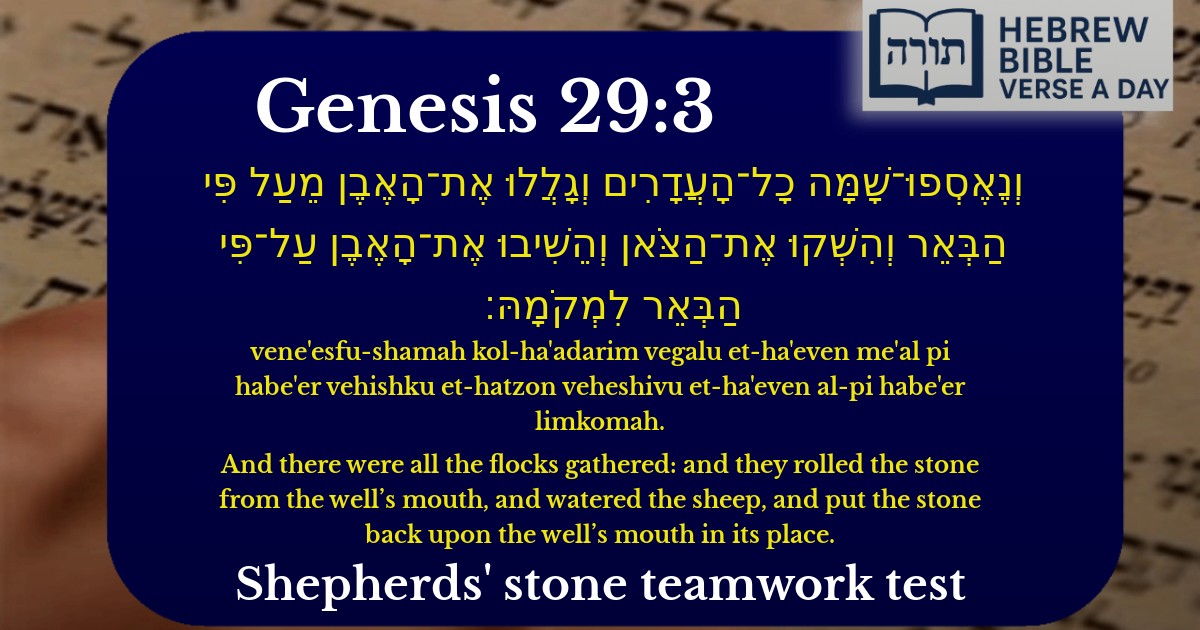Join Our Newsletter To Be Informed When New Videos Are Posted
Join the thousands of fellow Studends who rely on our videos to learn how to read the bible in Hebrew for free!
Hebrew Text
וְנֶאֶסְפוּ־שָׁמָּה כָל־הָעֲדָרִים וְגָלֲלוּ אֶת־הָאֶבֶן מֵעַל פִּי הַבְּאֵר וְהִשְׁקוּ אֶת־הַצֹּאן וְהֵשִׁיבוּ אֶת־הָאֶבֶן עַל־פִּי הַבְּאֵר לִמְקֹמָהּ׃
English Translation
And there were all the flocks gathered: and they rolled the stone from the well’s mouth, and watered the sheep, and put the stone back upon the well’s mouth in its place.
Transliteration
Vene'esfu-shamah kol-ha'adarim vegalu et-ha'even me'al pi habe'er vehishku et-hatzon veheshivu et-ha'even al-pi habe'er limkomah.
Hebrew Leining Text
וְנֶאֶסְפוּ־שָׁ֣מָּה כׇל־הָעֲדָרִ֗ים וְגָלְל֤וּ אֶת־הָאֶ֙בֶן֙ מֵעַל֙ פִּ֣י הַבְּאֵ֔ר וְהִשְׁק֖וּ אֶת־הַצֹּ֑אן וְהֵשִׁ֧יבוּ אֶת־הָאֶ֛בֶן עַל־פִּ֥י הַבְּאֵ֖ר לִמְקֹמָֽהּ׃
Parasha Commentary
📚 Talmud Citations
This verse is not quoted in the Talmud.


Context in the Torah
This verse (Bereshit 29:3) describes the scene at the well in Charan, where Yaakov Avinu first encounters Rachel. The shepherds would gather their flocks, remove the large stone covering the well, water the sheep, and then return the stone to its place. This detail sets the stage for Yaakov's act of kindness when he single-handedly rolls away the stone for Rachel (Bereshit 29:10).
Rashi's Explanation
Rashi (Bereshit 29:3) notes that the stone was exceptionally heavy, requiring multiple shepherds to move it. This emphasizes the miraculous nature of Yaakov’s later action, as he alone was able to roll it away—demonstrating either extraordinary physical strength (as the Midrash suggests) or divine assistance due to his righteous intent to help Rachel.
Symbolism of the Stone
The Midrash (Bereshit Rabbah 70:8) interprets the stone as symbolic of the obstacles in life that require collective effort to overcome. Only when the shepherds worked together could they remove it. Alternatively, some commentators (like the Kli Yakar) suggest the stone represents the yetzer hara (evil inclination), which can only be overcome through unity or divine merit.
Halachic Insights
Moral Lessons
The Netziv (Ha'amek Davar) explains that the shepherds’ adherence to returning the stone reflects their integrity in maintaining order. This contrasts with later generations who neglected such safeguards (as seen in the deterioration of societal norms before the Flood). Yaakov’s willingness to act alone for Rachel’s sake models the importance of initiative in performing chesed (kindness), even when others delay.